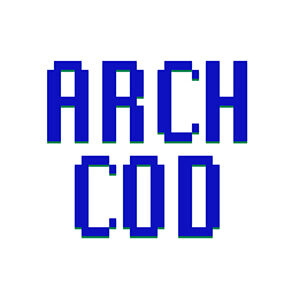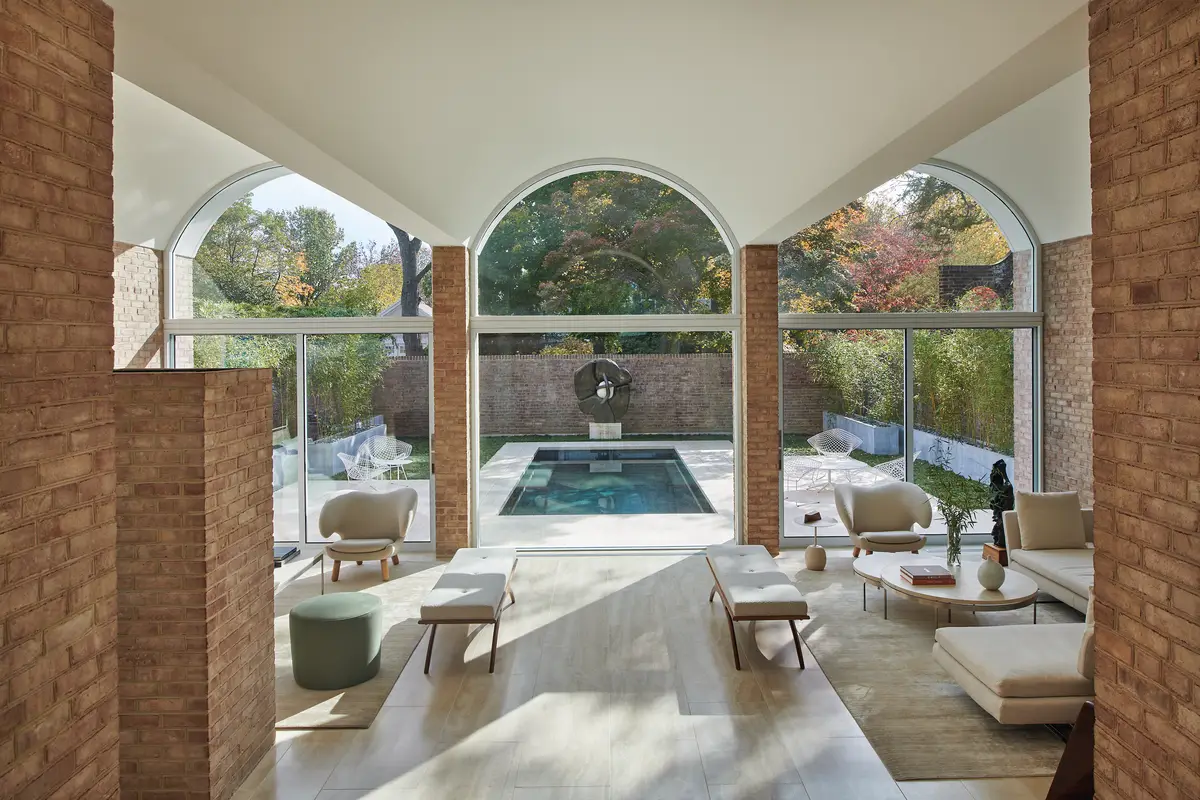Robert Gurney Revives a Rare I.M. Pei–designed Residence
✕
Indeed, the triple-barrel-vaulted house in the hilly Cleveland Park neighborhood of Washington, D.C., stands out among its pitched-roof neighbors. But one doesn’t anticipate much from it, dwarfed as it is by the stately two- and three-story residences on either side of it, as well as along the rest of the undulating block. A freestanding brick wall positioned 33 feet in front of the house reaches right about eye level, so that just the tops of the vaults are visible, further highlighting this plot’s peculiarity and leveling expectations of what lies beyond.

The brick wall that fronts the barrel-vaulted house (top of page) conceals a courtyard with pool (above). Photo © Anice Hoachlander, click to enlarge.
But step inside and everything changes.
What appears as a squat one-story building from the street opens up as a spacious, split-level volume cascading toward the back, where the site slopes significantly. The author of this singular structure, published as a Record House in these pages in 1964, is none other than I.M. Pei. One of only three houses the Pritzker Prize–winner designed in the course of his seven-decade career—which included a weekend retreat for his own family in Katonah, New York (1952)—the three-bedroom residence was built for William L. Slayton, who, as commissioner of the Urban Renewal Administration in D.C., knew Pei. “I remember clearly the day when . . . I walked through what is now the glass doors into this space, and for the first time realized what I.M. Pei had conceived,” Slayton told RECORD at the time. “It was a tremendously moving and emotional experience; I shall never forget it.”

Sunlight coming through the full-height glass facade bathes the living room. Photo © Anice Hoachlander
Even today, that sensation is not lost on first-time visitors, like myself, during a tour of the space on a beautifully bright day in late January. The spatial drama that Pei excelled at in his larger buildings, such as the Bank of China Tower in Hong Kong (1990) and the Museum of Islamic Art in Doha (2008), happens here at a smaller scale, and, as in those other projects, without warning.

Risers were eliminated in the central stair to visually connect the different levels. Photo © Anice Hoachlander
The house’s current residents had the same reaction during their initial viewing, over 15 years ago. They purchased the property almost immediately and lived in it for more than a decade before undertaking a major renovation and addition.
Originally designed as it was for a government employee, the modest house lacked the extras that contemporary families desire: a large kitchen, guest quarters, storage, and some of the basics, like a garage. In a previous renovation some 20 years ago, by noted architect Hugh Newell Jacobsen, even the third bedroom was eliminated, to open up the upper level of the central vault.
A major intervention on such a rare structure—it was added to the National Register of Historic Places in 2008—might intimidate most architects. But, in the hands of Robert Gurney, a respected local practitioner who counts Jacobsen as a strong influence—and with whom his wife, Therese Baron Gurney, the interior designer on this project, worked for many years—the renovation is both deferential and daring, executed under the watchful eye of the city’s Historic Preservation Review Board.
The entire house was stripped to the wood framing, brick walls, and concrete vaults. From there, necessary upgrades—including those to HVAC, plumbing, and electrical systems—were made, insulation added, roofing and single-pane glazing replaced, and a structurally improved floor system installed. “We were fortunate enough to have Pei’s drawings,” says Gurney. “These are all new windows, for example, but their details exactly match the originals. This house is like a museum. We wanted to restore it to museum quality but make it look as if we did nothing.”
To give the clients the extra space they desired, however, required a lot. Gurney dug deep into the hill, adding close to 1,000 square feet beneath the existing dining room and a new outdoor deck. Temporary steel beams and concrete underpinning supported the masonry pier structure during excavation, which went down to the level of the rear alley. On the opposite side of the deck, just beside that passageway, he designed a two-story structure that comprises a garage topped by a wood-and-glass office wrapped in perforated metal screens—what Gurney calls a “non-building.”

Designed with a different tectonic from the house, the tranquil retreat’s glass walls are wrapped in a perforated metal screen that modulates sunlight. Photo © Anice Hoachlander

The new two-story structure that sits across the rear deck is intended as background to the house. Photo © Anice Hoachlander

An office is located above the brick plinth of the garage. Photo © Anice Hoachlander
The subterranean portion added guest quarters, a media room, a wine cellar, and storage, but more changes occurred upstairs. An expanded kitchen was moved from the lower level of the east vault to that of the west one, in a space that previously contained the family room and a bathroom.

A subterranean addition includes guest quarters. Photo © Anice Hoachlander

The kitchen was moved and enlarged. Photo © Anice Hoachlander

The main bedroom occupies the upper level of the west vault. Photo © Anice Hoachlander
From one level to the next, interior to exterior, old to new, and original architect to subsequent ones, a continuity runs through the house. Take the travertine floor, which extends from the front courtyard through the main house and out again to the rear deck. White lacquer and walnut similarly find their way into most spaces. Carefully orchestrated walls (of brick nearly identical to the original and with the same grapevine joint), stairs, pathways, and gardens unite the structure. Furnishings span reimagined family heirlooms, classic midcentury pieces, and carefully curated contemporary selections. The overall result is stunning. Hugh Newell Jacobsen would say, “Do the right thing,” when working on his renovation. Robert Gurney did that, and more.
Click drawings to enlarge

Credits
Architect:
Robert M. Gurney, FAIA, Architect — Robert M. Gurney, principal; Matt Stephens, project architect
Engineer:
Cobb Architectural Engineers (structural)
Consultants:
Baron Gurney Interiors (interior design); George Sexton Associates (lighting); Simpson Gumpertz & Heger (building enclosure); Atlantic Control Technologies (home integration)
General Contractor:
Peterson & Collins
Client:
Withheld
Size:
4,750 square feet
Cost:
Withheld
Completion Date:
October 2024
Sources
Masonry:
American Restoration
Corrugated Metal Screens:
Elemental Metals
Skylights:
Velux
Special Surfacing:
Rugo Stone (travertine floor); Dekton (wallcovering, countertops); Daltile (floor and wall tile)
Doors:
Western Windows (sliding); Hope’s Windows (interior steel and glass); Clopay (garage)
Windows:
Livello (wood frame); Western Windows (metal frame)
Custom Woodwork:
Allegheny Wood Works
Hardware:
C.R. Laurence, Halliday & Baillie (pulls); Tectus (concealed hinges); FSB (locksets)
Kitchen Cabinetry:
Boffi
Lighting:
Ecosence, Eklipse, Luminii, Dado (interior ambient); Lucent (downlights); Lucifer, Luminii, Bega, Optic Arts (exterior); Lutron (controls)
Paints & Stains:
Benjamin Moore


